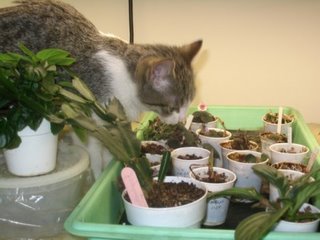 NOW is the time to think about disbudding for the upcoming spring show!!! Check your calendars and count the weeks, January 1st is quickly upon us!
NOW is the time to think about disbudding for the upcoming spring show!!! Check your calendars and count the weeks, January 1st is quickly upon us!Longtime growers will have their favorite schedule in mind when they're disbudding their show plants but for those of us that haven't found the best system for our own plants here's some timely advice that just might be a little different from what "THEY" usually say in the books!
First of all, they say that it's a good idea to switch to a high phosphorous fertilizer to induce bloom. This might work for the flowering, but it WILL make the plant show a change in it's horticulture months after the show. For those large standards that may take years to achieve their spectacular form and size you don't want to have whole rows of leaves looking different from the others.
They say that keeping to the typical schedule of disbudding will work for all your plants universally but keep in mind that most schedules are meant as helpful guidelines. With extra large standards you may very well find that you need to disbud almost two weeks before the recommended time because of the way that the great big ones grow. Variegated ones may differ from the average times suggested also.
They might have told you that if you have a blossom stem that's showing most of the flowers open a month (4 weeks) before the show you might as well leave it on the plant. Typically, a flower stalk that's this far along will have fading or spent blooms for the show. Take off these older bloom stems and with luck you'll get a new one that's young and fresh!
They say that if your plant is coming into bloom before a show too slow or too fast that you can move the plant to a warmer location to speed the blooming up or to a cooler location to slow it down. They are pretty savvy about this tip but something a bit more radical might work too. Putting the plant in a dark location for a few days will slow down the flowering and putting it under continuous light for a few days will speed things along. Overall, plants need their dark time to process the products of photosynthesis made during the daytime but for a brief period this trick seems to speed up the bloom cycle.
They say that you should grow duplicates of a single variety because, like people, some will grow a little faster and some a little slower. This is good advice if you are a grower with a lot of space but for those a little pressed for room there are more factors to consider. Things like placement on the shelf can produce differences in flowering. How good a job you did at disbudding might be a factor. You were probably quite thorough disbudding the first few violets, but after the 47th plant you weren't so particular and these plants will obviously tend to show their flowers sooner.
They say that resetting the timers for more hours of light a day will help speed up the blooming and they are correct but there's more to consider with this statement. If your plant is vigorously growing and quite root-bound, not to mention disbudded, it seems that the number of hours isn't as critical as you might expect. The healthy, robust, root-bound plant will come into flower no matter what you do. So adjusting the light timers may not be making as big a difference as you want. Growers will find it useful to experiment with the lighting in their own growing location but remember to try a few of these other ideas like differing the placement on the shelves, slightly changing the temperature in the growing environment or keeping the plants more or less root-bound.
Well, you know what they say.... You better give credit where credit is due! Thanks to S. Johnson for providing all the useful insights for this post! Comments and questions are welcomed and appreciated, let us know what you think. The picture shows one of the lovely commercial tables at the 2006 National Convention.












